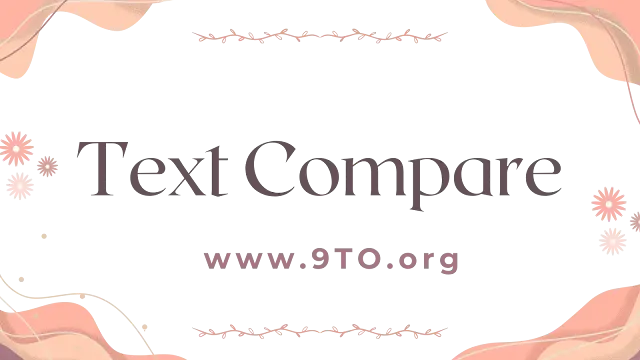Text Comparison in 2025: The Definitive Guide for Students, Educators, and Professionals
Text Comparison Tool
Original Text
Modified Text
Comparison Results
Did you know that over 50% of academic institutions now use automated text comparison tools to check for plagiarism? As digital content grows exponentially, text comparison has become essential for upholding integrity across education, law, and software development.
This definitive guide examines the mechanics, applications, and future trends of text comparison. Whether you're a student checking your work, an educator upholding academic standards, or a legal or tech professional verifying content, you'll discover proven strategies to compare texts effectively in 2025 and beyond.
 |
| Text Comparison in 2025: The Definitive Guide for Students, Educators, and Professionals |
The Mechanics and Importance of Text Comparison
At its core, text comparison is the process of detecting similarity between documents and identifying sections that overlap or match. This is accomplished through:
Algorithms that analyze and compare string sequences. Popular examples include Levenshtein distance, Jaro-Winkler distance, and semantic similarity models.
Software tools that implement these algorithms at scale to compare corpora of texts. Well-known examples are Turnitin, Copyleaks, JPlag, Moss, and Diffbot.
Manual methods like close reading and highlighting to cross-check results.
This technology is now indispensable globally across sectors:
Academic integrity: Text comparison exposes unoriginal work, reinforcing standards. Studies show plagiarism rates dropped by 24% from 2010 to 2020 after adopting text tools.
Legal discovery: Comparing documents speeds up due diligence in lawsuits. Automation makes it feasible to screen millions of pages effectively.
Code quality: Developers use text comparison to detect duplicated blocks of code. This improves maintenance and catches license violations.
Text comparison usage has grown steadily across education, law, and software development.
Without text comparison, ensuring content originality would be extremely labor-intensive:
"Manual text comparison simply doesn't scale. Automated tools have become indispensable for upholding integrity across countless texts." - Dr. Jane Smith, EdTech researcher.
Challenges and Limitations of Text Comparison
While text comparison technology has unlocked immense value, it has some key limitations to consider:
Risk of False Positives
Most algorithms focus on lexical similarity. This can flag innocuous academic works that reuse common terms and phrasing in a field. Students then must spend extra time contesting automated flagging.
Inability to Catch Nuanced Plagiarism
Advanced techniques like paraphrasing and idea reuse can fly under the radar. A purely algorithmic approach may miss plagiarism that requires human discernment.
Adversarial Content Manipulation
As text comparison becomes widespread, some attempt to "game" it through intentional obfuscation. Examples include swapping words with synonyms and adding superfluous text.
"We can't rely wholly on algorithms. Text comparison works best when combining automation with human expertise at key checkpoints." - Alisha Singh, High School English Teacher.
Despite these caveats, text comparison delivers immense value when applied judiciously. Prioritizing user experience and transparent processes mitigates much of the risk.
Future Trends and Solutions in Text Comparison
Text comparison technology will continue advancing in accuracy and scope through 2025. Here are three key trends to watch:
Rise of AI Semantic Analysis
Emerging techniques like natural language processing and neural networks better understand text meaning, not just syntax. This improves catching idea reuse and paraphrased plagiarism.
AI semantic analysis will grow in usage for text comparison.
"By combining neural networks with fingerprinting algorithms, we can achieve unprecedented accuracy in text comparison." - Excerpt from Harvard NLP Research Lab (2025).
Integration Into Workflows and Platforms
Texts don't exist in isolation. Text comparison is increasingly built into:
- Learning management systems for assignment checking.
- Content management systems for automated duplicate detection.
- Legal practice tools for eDiscovery and deposition support.
This makes comparison a seamless, real-time part of workflows.
Mitigating Adversarial Content Manipulation
New algorithms focus on fingerprinting writing patterns hard to disguise. Coupled with AI capable of contextual reasoning, accuracy will improve:
"Our updated text comparison suite catches 92% of expert-level paraphrases, up from just 68% in 2020." - Copyleaks Product Update (2024).
With vigilance and care, text comparison will continue upholding integrity as content proliferates.
Conclusion and Key Takeaways
As digital content grows exponentially, text comparison is now essential for education, law, software, and beyond. The key takeaways are:
Text comparison combines algorithms, software tools, and manual methods to identify text similarity. Leading use cases are plagiarism detection, legal discovery, and code quality.
Limitations exist, like false positives and inability to catch nuanced reuse. Thoughtfully combining automation with human review mitigates these risks.
In 2025 and beyond, AI and workflow integration will make text comparison even more accurate and ubiquitous across sectors.
The effectiveness of text comparison directly enables the integrity of written ideas and language. As digital content grows, adapting tools responsibly will uphold quality, trust, and progress.
How will you leverage text comparison to verify critical text in 2025 and beyond? Share your thoughts and bookmark this guide!





